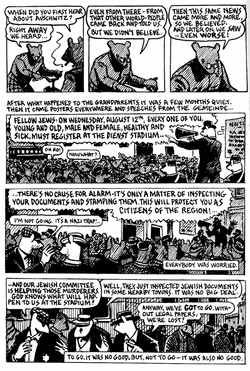Maus final analysis
In this page from Maus, by Art Spiegelman, Vladek is faced with a choice between registering as a Jew and taking the risk of it being a Nazi trap or not registering and not having legal papers with him. Vladek says "To go, it was no good, but, not to go - it was also no good" (Spiegelman 90). In Vladek's case this means that Vladek will face danger whether he goes the Dienst stadium or not. This quote is very accurate when describing the Jew's situation at the time. There was no good alternative. They were stuck in the Holocaust. This page also shows Art's drawing ability to make the audience focus on one part rather than the other. In the fourth box, he draws the three Jews delivering the news in detail, while everyone else is shaded in. Similarly, in boxes four and five, Vladek and the people he is talking to are drawn in detail, while the others are shaded in. This attention to detail makes Maus such a powerful book. The book reminds us that we cannot truly understand the trauma that the Jews went through during the Holocaust. We can only remember the Holocaust so we do not repeat the same mistakes. In this sense the book serves as Art's memorial of Vladek. At memorials we can't know what they went through or change what happened. We can only preserve their memory. This is Art's way of preserving Vladek's memory and coping with his survivor's guilt.

Comments
Post a Comment